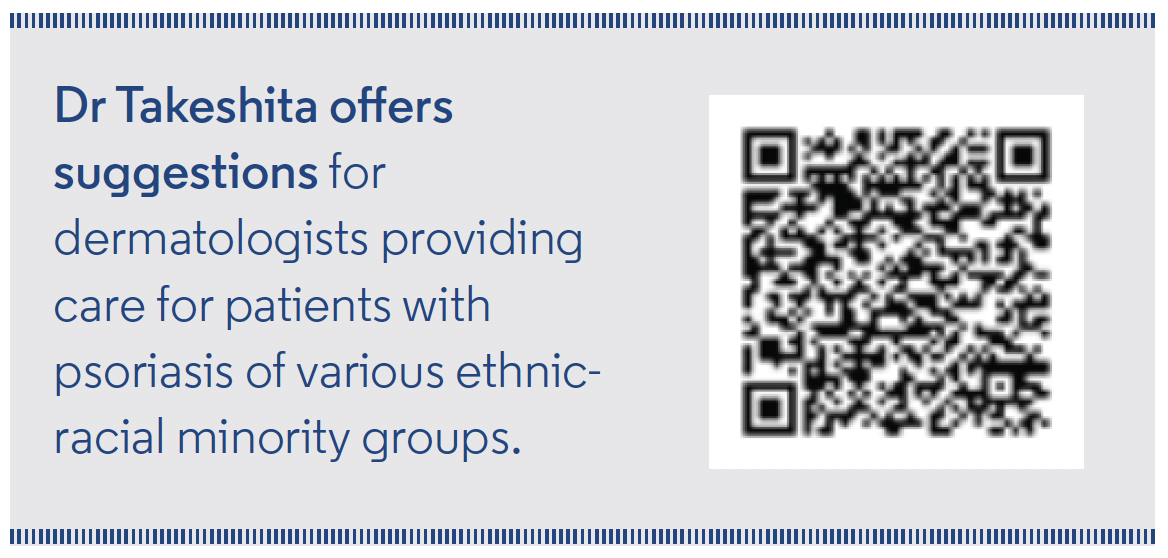 As antiracist movements grow in strength in many aspects of daily life, academia continues to research potential differences in care among racial and ethnic minority groups. A research group out of the University of Pennsylvania, headed by Junko Takeshita, MD, PhD, MSCE, has explored the intersection of race/ethnicity and psoriasis. In a 2015 study, the group found that the odds of receiving a biologic therapy to treat psoriasis was 69% lower in Black patients than in White patients.1 More recently in 2019, Dr Takeshita and colleagues examined patients’ perceptions of biologic therapies to treat psoriasis in an effort to understand racial disparities in psoriasis treatment.2 Unfamiliar was a common term that came up among Black biologic-naïve participants in the qualitative freelisting study when they were asked to describe self-injectable biologics. Interestingly, unfamiliar was not a term that was voiced by White biologic-naïve patients when asked the same question. The study findings suggest that this lack of familiarity may be an important contributor to the racial disparities seen in the use of biologics in Black vs White patients.1
As antiracist movements grow in strength in many aspects of daily life, academia continues to research potential differences in care among racial and ethnic minority groups. A research group out of the University of Pennsylvania, headed by Junko Takeshita, MD, PhD, MSCE, has explored the intersection of race/ethnicity and psoriasis. In a 2015 study, the group found that the odds of receiving a biologic therapy to treat psoriasis was 69% lower in Black patients than in White patients.1 More recently in 2019, Dr Takeshita and colleagues examined patients’ perceptions of biologic therapies to treat psoriasis in an effort to understand racial disparities in psoriasis treatment.2 Unfamiliar was a common term that came up among Black biologic-naïve participants in the qualitative freelisting study when they were asked to describe self-injectable biologics. Interestingly, unfamiliar was not a term that was voiced by White biologic-naïve patients when asked the same question. The study findings suggest that this lack of familiarity may be an important contributor to the racial disparities seen in the use of biologics in Black vs White patients.1
The Dermatologist spoke with Dr Takeshita on how dermatology can provide more equitable psoriasis care for patients from racial and ethnic minority groups. She is an assistant professor in the departments of dermatology and epidemiology, biostatistics and informatics at the University of Pennsylvania Perelman School of Medicine in Philadelphia.
Q. What are some common misconceptions about psoriasis in skin of color?
A. I would like to start by making a distinction between race and ethnicity and skin of color. While racial and ethnic minority groups tend to have darker skin types, or what we are calling skin of color in dermatology, I think it is an important distinction to understand. Race and ethnicity are social constructs in which skin color can play an important and defining role. Sometimes the term skin of color is used in dermatology to encompass all people of non-White race or ethnicity. In dermatology, we also classify skin by phototype (or the Fitzpatrick skin type), which is based on a person’s response to UV exposure. Sometimes people interpret skin of color to refer to higher (and typically darker) skin phototypes. The reason why I make a distinction is because the studies that I am going to reference to answer your question are based on racial and ethnic differences in psoriasis prevalence and treatment.
One misconception is that psoriasis does not occur in non-White populations, and that is absolutely not true. While we presently do not have a lot of epidemiologic data about the prevalence of psoriasis in populations other than White or European-descent groups, existing data currently suggest that psoriasis is a little bit less common in ethnic minority groups than among Whites.3 It is unclear if this represents a true prevalence difference or whether the difference may be in part due to underdiagnosis of psoriasis in minority groups. That said, our current prevalence estimates of psoriasis in racial and ethnic minority groups still puts psoriasis as a common skin disease, so that is one important misconception that we need to correct.
Another thing to be aware of is that psoriasis may be more severe among racial and ethnic minority groups, especially Black individuals,3 based on the limited data we have on this. Furthermore, the quality-of-life burden of psoriasis appears to be greater among racial/ethnic minority groups, independent of any objective disease severity differences.4
These are some common misconceptions that we need to correct within dermatology and explain to patients so that they understand psoriasis is common across all individuals and that there may even be a larger burden of disease in our minority patient populations.
Q. What barriers to care do racial-ethnic minority groups face when it comes to treatment of their psoriasis?
A. In terms of barriers to care, we do have existing data that show that minority groups are less likely to see a dermatologist for their psoriasis in the United States.5 It is yet unclear exactly why this is; I think things that can potentially contribute to this include medical insurance status and geographic proximity to a dermatologist. But even if these individuals have access to a dermatologist, their care may be limited by the familiarity of that dermatologist with diagnosing and treating psoriasis among minority populations. I think certainly access to medical providers who feel confident in diagnosing and treating psoriasis in diverse populations is a major barrier to our minority patients receiving adequate care for their skin disease.
Q. Are there any differences in approach to treatment in patients with darker vs lighter phototypes?
A. Yes, absolutely there are considerations that we should think about in managing psoriasis in lighter vs darker skin types. In darker skin types, psoriasis tends to present and look differently than psoriasis presenting in lighter skin types. The typical description of psoriasis that we are taught either as medical students or dermatology trainees is that psoriasis presents as bright red plaques with silvery scale. Now, in darker skin types, that red color is often not quite as apparent. It can look more purple or violaceous or can simply look hyperpigmented, the latter of which can be mistaken as inactive disease or post-inflammatory hyperpigmentation (PIH). In darker skin types, any sort of inflammatory skin disease or skin injury is also more likely to resolve with PIH.
Regarding PIH, the best “treatment” is prevention. In individuals with more severe psoriasis and who are darker skin ned, you may want to think about being a little more aggressive with your therapy to prevent that PIH because PIH itself is difficult to treat.
ned, you may want to think about being a little more aggressive with your therapy to prevent that PIH because PIH itself is difficult to treat.
It is also important to educate our patients with darker skin types about PIH so they are aware that this is something that is going to happen after their psoriasis resolves. It is not uncommon for my patients with darker skin types to come back and tell me that they have continued to apply their topical steroids, for example, to a hyperpigmented spot, thinking that is still active psoriasis, when we do not want our patients applying topical steroids to PIH alone.
Another reason to educate patients about PIH is to allay some anxiety regarding dark spots after a psoriasis lesion resolves. Patients often think these dark spots are scars, and it is important to let our patients know that, in most cases, PIH is not permanent, though it can take several months to resolve. We need to emphasize that PIH is not permanent like scars.
In thinking about the different therapy options that we have for patients, it is important to understand that patients with darker skin types also need higher doses of phototherapy to have an adequate response to treatment. For those of us who are administering phototherapy to our patients with darker skin types, it is critical to not only have that knowledge but be comfortable with increasing and giving those higher doses to our darker skinned patients, as recommended by the joint National Psoriasis Foundation and American Academy of Dermatology guidelines,6 so that they have a similar benefit from phototherapy as their lighter skinned counterparts.
References
1. Takeshita J, Gelfand JM, Li P, et al. Psoriasis in the U.S. Medicare population: prevalence, treatment, and factors associated with biologic use. J Invest Dermatol. 2015;135(12):2955-2963. doi:10.1038/jid.2015.296
2. Takeshita J, Eriksen WT, Raziano VT, et al. Racial differences in perceptions of psoriasis therapies: implications for racial disparities in psoriasis treatment. J Invest Dermatol. 2019;139(8):1672-1679.e1. doi:10.1016/j.jid.2018.12.032
3. Gelfand JM, Stern RS, Nijsten T, et al. The prevalence of psoriasis in African Americans: results from a population-based study. J Am Acad Dermatol. 2005;52(1):23-26. doi:10.1016/j.jaad.2004.07.045
4. Shah SK, Arthur A, Tang YC, Stevens S, Alexis AF. A retrospective study to investigate racial and ethnic variations in the treatment of psoriasis with etanercept. J Drugs Dermatol. 2011;10(8):866-872.
5. Fischer AH, Shin DB, Gelfand JM, Takeshita J. Health care utilization for psoriasis in the United States differs by race: an analysis of the 2001-2013 Medical Expenditure Panel Surveys. J Am Acad Dermatol. 2018;78(1):200-203. doi:10.1016/j.jaad.2017.07.052
6. Elmets CA, Lim HW, Stoff B, et al. Joint American Academy of Dermatology–National Psoriasis Foundation guidelines of care for the management and treatment of psoriasis with phototherapy. J Am Acad Dermatol. 2019;81(3):775-804. doi:10.1016/j.jaad.2019.04.042
























